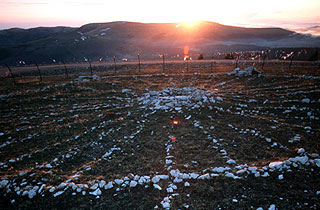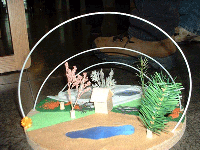|
 |
Where Does the Sun Rise and Set?
|
|
Most people know that the
Sun "rises in the east and sets in the west".
However, most people don't realize that is a generalization.
Actually, the Sun only rises due east and sets due west on
2 days of the year -- the spring and fall equinoxes!
On other days, the Sun rises either north or south of "due east"
and sets north or south of "due west."
Each day the rising and setting
points change slightly. At the summer solstice, the Sun rises as far
to the northeast as it ever does, and sets as far to the northwest.
Every day after that, the Sun rises a tiny bit further south.
|
At
the fall equinox, the Sun rises due east and sets due west. It
continues on it's journey southward until,
at the winter solstice, the Sun rises are far to the south as it ever does,
and sets as far to the southwest.
Many, if not most, prehistoric cultures tracked these
rising and settings points with great detail.
If they had jagged mountains along the horizon, the exact points could be
readily remembered. Without a suitably interesting horizon, standing stones
could be arranged to line up with
the various rising and setting points. Or, tree poles could replace
the standing stones. Or, rock cairns could be used.
|
How does this work?

|
The dioramas simulate the rising and setting points of the Sun,
and its tracks across the sky at summer solstice
(longest track), winter solstice (shortest track), and the spring and fall
equinoxes (medium track). A bead placed on one of the tracks
simulates the Sun rising along the eastern horizon, travelong along the sky,
and setting on the western horizon.
|

|
Imagine a tiny version of yourself standing in the middle of the wooden disk. And
imagine that the outside rim of the disk represents your horizon. On Summer
Solstice, you would see the Sun rise on your "horizon" at the eastern point of the
longest track. It would follow the track high in your sky, and eventually
set on the western horizon. It would be up for about 17 "hours", thus making
summertime days long and warm.
On the Winter Solstice, you would observe the Sun rising at the western end of the
smallest track. It wouldn't rise high in the sky, and would be up for only about
6 or 7 hours, making your days short on daylight and cold.
At the Spring and the Fall equinoxes, the Sun would rise at the east end of the middle
track and set at the west end. Your days would be exactly half daylight and half nighttime
and you would experience typical warm/cool spring and fall climates.
What about the stars?
|
The rising points of the stars don't change as much as the Sun's because
they are so very far away. So the rising points of stars on the horizon were
not as critical to ancient cultures.
However, the rising times of stars change by 4 minutes each day, so
any particular star would rise at different times during the year. For
about half the time, the star would rise during the daytime and thus be
blocked by the huge light of our Sun.
|
There was something called
the "heliacal" or dawn rise of a star -- and this happened on only one day of
the year.
Thus these dawn rising were extremely useful for keeping track of exact days.
For an explanation and examples of heliacal or dawn risings of stars, see
Show Me a Heliacal Rising.
|
Return to Ancient Observatories -- Timeless Knowledge
Image credits:
- Medicine Wheel sunset photograph by Tom Melham.
The Tom Melham picture appeared in the National Geographic.
According to them, it is part of a collection
"Mysteries of Mankind: Earth's Unexplained Landmarks" and the image
is listed
as usuable, with no permission or payment required. Just need to
give credit, which is:
Medicine Wheel sunset photograph by Tom Melham.
- Native American Suntrack Diorama photo and design by Ginger Armstrong, Kelseyville, CA.
- Seasons Suntrack Diorama photo by Ben Buress, Chabot Space and Science Center.
- Suntrack dioramas designed by Deborah Scherrer and Barbara Scherrer.
|

